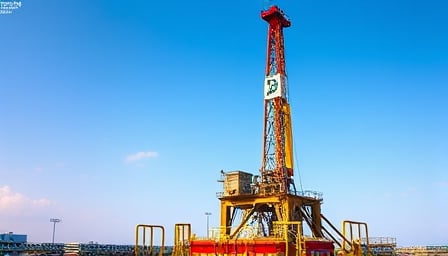Corporate News – Energy Market Analysis
PetroChina Co Ltd, a leading Chinese oil and gas producer, has recently recorded a moderate uptick in its share price, surpassing its 52‑week low and signalling a positive short‑term sentiment. The move reflects broader dynamics in the global energy markets, where commodity prices have risen under a confluence of supply‑side constraints and demand‑side recovery.
Market‑Cap Growth and Valuation Metrics
The company’s market capitalization has increased appreciably, driven by higher oil and natural‑gas prices and a growing confidence among institutional investors in China’s energy sector. Meanwhile, PetroChina’s price‑to‑earnings (P/E) ratio has edged upward, indicating that market participants are willing to pay a premium for the firm’s earnings potential. This valuation trend is consistent with a modest yet sustained recovery in energy demand, especially in Asia, where economic activity is picking up after pandemic‑induced slowdown.
Energy Supply‑Demand Fundamentals
- Oil Supply: OPEC+ production cuts, coupled with reduced output from non‑OPEC producers amid maintenance and geopolitical tensions, have tightened global supply.
- Gas Supply: The U.S. shale boom remains in place, but pipeline bottlenecks in key transit corridors have limited export capacity.
- Demand: Asia’s industrial and transportation sectors have rebounded, lifting demand for both oil and gas. The Chinese government’s emphasis on energy security and industrial revitalization has further underpinned demand growth.
These fundamentals have created upward pressure on Brent and WTI crude benchmarks, with WTI currently trading above $80 per barrel – a level not seen since early 2023. Correspondingly, natural‑gas prices in the Henry Hub have surged past $4 per MMBtu, supporting higher revenue streams for integrated energy firms.
Technological Innovations in Production and Storage
- Enhanced Oil Recovery (EOR): PetroChina has accelerated investment in CO₂‑EOR projects in its Xinjiang and Sichuan basins. The adoption of digital monitoring technologies has improved recovery rates by an estimated 3–5 %.
- Hydrogen Production: The company’s pilot electrolyzer units in Guangdong aim to produce low‑carbon hydrogen, aligning with China’s 2050 net‑zero target.
- Energy Storage: PetroChina is collaborating with battery manufacturers to deploy 30 MWh lithium‑ion storage systems in its refineries, enabling peak shaving and grid support services.
These initiatives position the firm to capture revenue streams from the evolving energy transition, while mitigating volatility associated with conventional hydrocarbon markets.
Regulatory Landscape and Policy Support
- Carbon Pricing: China’s national carbon market, launched in 2021, now covers the majority of its power and steel sectors. PetroChina’s integration of carbon capture and storage (CCS) is expected to provide a compliance advantage.
- Subsidies for Clean Energy: The recent policy to upgrade China’s chemical industry includes incentives for green chemicals and advanced materials, which could dovetail with PetroChina’s downstream activities.
- Export Controls: Ongoing U.S. export restrictions on certain high‑tech equipment have prompted the firm to diversify its supply chains, affecting short‑term capital expenditures.
Regulatory measures continue to shape the competitive environment, favoring firms that balance fossil fuel production with low‑carbon solutions.
Infrastructure Developments
- Pipeline Expansion: The new 10,000‑km gas pipeline network from Xinjiang to the eastern coast is slated for completion in Q4 2025, enhancing domestic gas distribution and reducing transshipment costs.
- Refinery Upgrades: PetroChina’s modernization program at the Dalian refinery has increased crude throughput by 15 % and improved catalyst life, contributing to higher refining margins.
- Digital Platforms: Implementation of an AI‑driven asset‑management system has reduced downtime in upstream operations by 8 %, translating into cost savings.
These infrastructure projects underpin the company’s operational resilience and are expected to support future earnings growth.
Trading Dynamics vs. Long‑Term Transition
Short‑term traders are focusing on the immediate impact of geopolitical events—such as U.S. sanctions on Russian energy exports—and market sentiment shifts in response to earnings releases. The resulting volatility is reflected in the spread between spot and futures prices for both oil and gas.
In contrast, long‑term investors are increasingly weighing the trajectory of the energy transition. PetroChina’s investments in renewables, CCS, and hydrogen position it to benefit from the gradual shift toward decarbonized energy systems. The company’s ability to pivot between fossil fuel extraction and low‑carbon technologies will be a key determinant of its competitive advantage in the coming decade.
Outlook for PetroChina
While the company’s share price has not yet matched the aggressive gains of some peers in the sector, its solid fundamentals, strategic investments, and supportive regulatory environment suggest that PetroChina remains a resilient participant in the evolving energy landscape. Market volatility is likely to persist, driven by global oil price swings and the firm’s debt profile. Nevertheless, the convergence of supply constraints, demand recovery, and technology adoption creates a favorable backdrop for sustained growth in the medium term.
